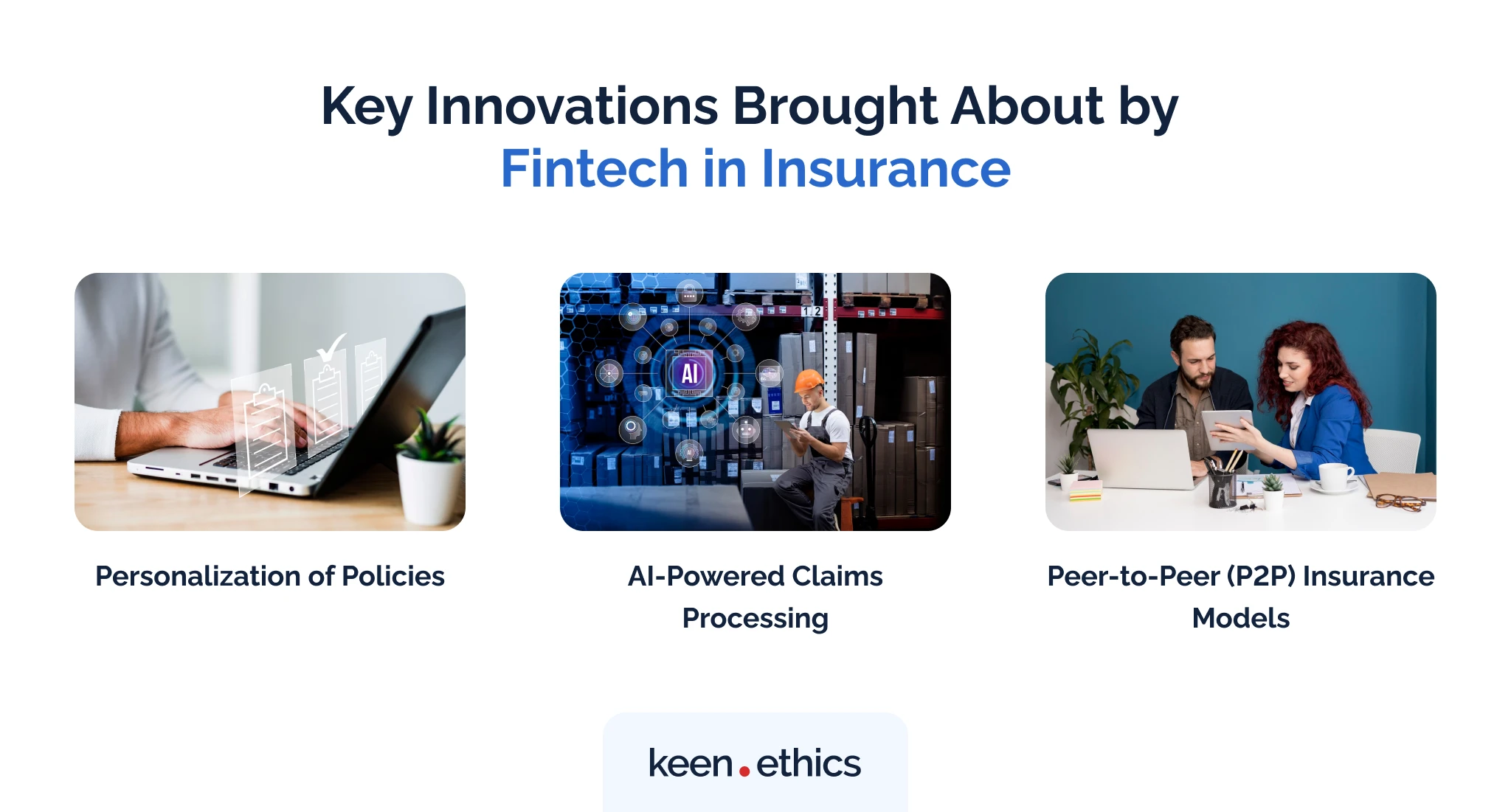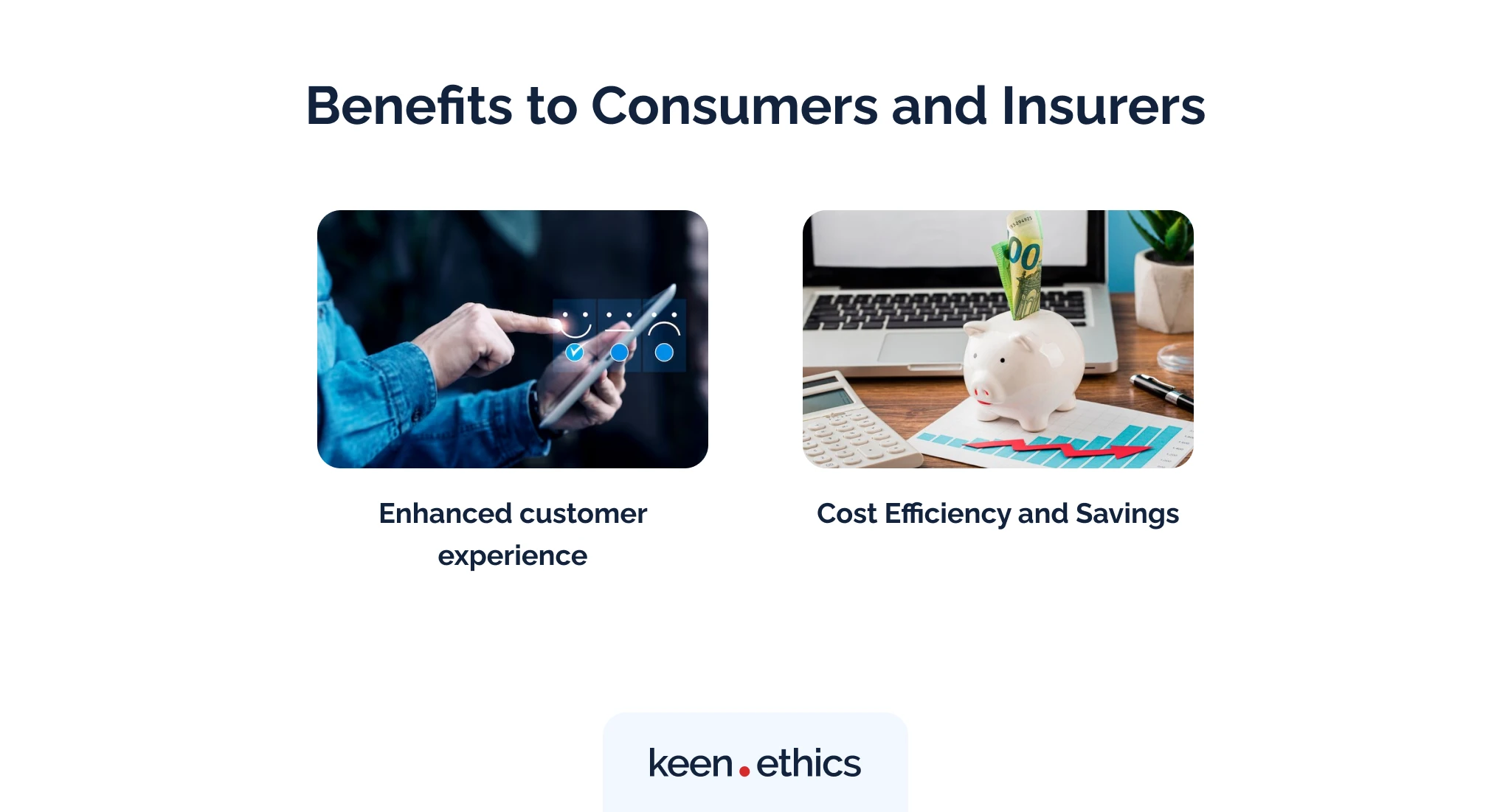The insurance sector needs reform. The fintech revolution will reshape this industry.
I. Introduction
Neobanks are extremely popular today; at the same time, neoinsurance companies essentially don’t exist. “Neoinsurance” isn’t a real term, too: in fact, we’ve invented it specifically for this article. Why? Our goal is to show how conservative the insurance industry tends to be. It relies on pre-written policies that often reflect various biases. As a result, millions of people have no access to insurance today. While banks enjoy tremendous progress, insurance tends to use decades-old technologies.
Financial technologies or fintech in insurance sector may finally offer a solution to this problem. Innovations such as AI and peer-to-peer services can remove many insurance barriers: in this article, we’ll review them. As you’ll find out, we’re about to see the rise of insurance technology. Ultimately, insurtech is the future of insurance.
II. The Rise of Insurtech
Fintech is already a significant trend in modern finance. It’s not surprising that this set of innovations is now transforming an adjacent industry, insurance. Let’s review what insurtech is and what prospects the sector has.
A. Definition and explanation of “Insurtech”
Etymologically, insurtech is a blend of “insurance” and “technology.” It involves the use of modern computer-based technology to improve the insurance industry. What tools do insurtech companies use? They leverage mobile apps, artificial intelligence, and big data analysis to streamline insurance. The idea is to make insurance more user-friendly and accessible financially.
Firstly, it simplifies policy and claims analysis for workers. This approach is vital because it decreases the cost of an average insurance plan on the market. Secondly, a key factor is to make it easier to use insurance through digital tools. With insurtech, one can receive insurance with several button presses via their smartphone. This upgraded experience should push more people to consider different insurance plans. Insurers can also better assess risk and make policies that fit everyone’s needs. Ultimately, insurtech creates a more personalized and responsive insurance landscape. For insurance businesses, it offers greater prediction accuracy, which is essential for preventing financial losses.
B. The growth trajectory of insurtech startups

Current projections for the insurtech sector are incredibly optimistic, despite the conservatism of the insurance sector executives. It’s not surprising why. Insurtech covers the demands of both younger and older users. On the one hand, it removes the need to visit banks or insurance firm offices. On the other hand, it makes insurance more accessible to previously underserved populations.
For this reason, we expect that the value of the sector will be growing for many years to come. What are the existing projections? Mordor Intelligence, an analytical company, states that the insurtech market will grow to 10.1 billion by 2025. In 2019, it amounted to 5 billion dollars.
Technologies such as AI insurance analysis and P2P lending make insurtech increasingly popular. The more powerful they get, the faster this sector will expand. The appearance of regulatory interventions is also likely. It’ll make the industry more reliable and protect consumers. All in all, investments in the insurtech sector make sense.
III. Key Innovations Brought About by Fintech in Insurance

Fintech in insurance sector brings about multiple innovations. They all solve significant problems of the original systems. Here they’re:
A. Personalization of Policies
We need to review the limitations of past insurance systems to understand why personalization is so vital.
Past policies
The critical problem of past insurance was calculation. Traditional insurance organizations interacted (and still interact) with millions of customers. These companies had to analyze all their cases to guarantee profit. Miscalculations regarding risk inevitably led to losses. In this light, traditional companies had two choices.
On the one hand, they could focus on generalizations. The idea here was to have several reliable profiles and target only them. For example, higher education and at least a mid-income job were common factors. All other people were excluded from insurance due to unreliability.
On the other hand, companies with larger resources could hire more workers. They had to analyze individual cases and target more non-conventional applications. In this scenario, fewer people ended up without insurance, but it started to cost more. For instance, Berkshire Hathaway currently employs well over 300 thousand individuals. Obviously, the business has to spend a lot to maintain this workforce.
All in all, both models are suboptimal. You either push away many clients or hire a massive insurer workforce. Considering that the modern world is getting increasingly complex, even the second solution is temporary.
Fintech personalization
Fintech leverages modern computing devices to solve the aforementioned issues. What does it do? It uses algorithmic and AI technology to calculate risk. Machine learning algorithms can analyze all data about a person in milliseconds. More importantly, there’s no longer any need to collect this data. Financial and governmental records are becoming more and more digitalized.
Consequently, all an algorithm requires is user consent for reviewing those records. Ultimately, this approach removes the need to expand the workforce for better personalization. Modern AI can study millions of cases daily and generate new policy based on risk analysis. A realistic path towards automation in the insurance sector exists.
In the future, insurtech will allow users to get insurance by downloading an app and pressing several buttons. Some companies that approach this model already exist. NEXT Insurance, for example, uses AI to offer instant quotes for small businesses. Getting high-quality feedback on insurance has never been as easy as today.
B. AI-Powered Claims Processing

Claims processing also needs insurtech. Let’s review why and how fintech AI solves these challenges:
Problems with claims processing in traditional companies
AI is important not only for risk analysis. It can also help in automating other tasks through RPA (robotic process automation or algorithm-based apps) and proper weak AI (predictive analytics and generative platforms). Modern insurance companies require employees for two goals. Firstly, they must collect and analyze customer information. We’ve discussed this goal in-depth above. Secondly, they also have to process compensation claims. Every day, clients ask insurance providers to cover their expenses. Some user may want coverage for a car accident. Another individual may need funds to pay hospital bills. What’s the problem here? Analyzing if those claims are right or not is difficult.
This difficulty exists for two reasons. Above all, claims fraud is widespread. Statista reports that before COVID-19, up to 100000 fake claims per year were filed for motor accidents in the UK alone (2019). Another issue is that the number of applications is generally high. An average worker can easily lose a fraudulent case in the wave of compensation claims. All this once again pushes the industry to hire more and more people.
How AI solves the claims-related issues
AI doesn’t solve all problems with claims processes, but it helps reduce them. How? It can analyze documents and user accounts to make high-quality judgments. AI learns by reviewing a lot of information. This means it can easily find irregularities based on statistics. Machine learning tools review and approve thousands of claims without human input. After all, the majority of the clients are honest. They provide valid information and only need guidance to make it more transparent. An AI is perfect for filtering their cases and reducing the pressure on human analysts. Instead of having to analyze all the information, they now get to concentrate on the more complex cases.
The overall system is simple here. An AI reviews all claims and reports on their irregularities. Then, human workers make judgments on any controversies. In this way, spotting fraud is easier. After all, the insurance specialists can focus on it alone.
C. Peer-to-Peer (P2P) Insurance Models

Peer-to-peer (P2P) insurtech also makes modern insurance better. Let’s review what was wrong with old systems and how P2P changes this.
Problems of the old systems
The old model tends to focus on the low-risk clients. Even if there’s personalization, most companies still target limited groups. In this light, the accessibility of an average insurance product is low. Many underserved groups get no insurance. The premiums on average plans are too high to maintain. Occasionally, the risks may be palatable, but various insurance firms still avoid investment due to stereotypes. KFF reports that 27 million people in the US have no health insurance. Why? They can’t pay for it in the majority of cases. While the existing system needs transformation, P2P investment nonetheless improves the insurance situation.
P2P model: An outline
Collective effort brought about significant benefits for humankind. In many ways, this collective labor made humans human. For instance, humans united to overcome challenges, such as irrigation. Peer-to-peer insurance uses the same collective principles that brought success to our civilization. What does it do? P2P insurance uses a solidarity model. In this approach, some people or small groups cooperate to share risk. They pool resources to help each other in times of need.
In traditional insurance, individuals pay premiums to a central insurance company. It then uses those premiums to cover claims and operational expenses. Contrary to that, P2P insurance relies on a decentralized, community-based model. Within it, people pay premiums to a community, which then judges if specific claims make sense through democratic voting.
Some readers may say that the idea isn’t new. We agree: the mutual help sector was popular in the 19th and 20th centuries. A big problem with it was the absence of good control tools. Mutual help services had to rely on non-professionals to judge claims or hire experts. Now, the P2P lending sector can use an extensive app infrastructure that prevents fraud. Claims analysis is automatic, making voting on insurance claims easier.
Why P2P lending solves past problems
P2P insurance, more or less, solves the past issues of the insurance sector. Primarily, it enables insurance for previously underserved populations. Various minorities often face challenges while getting insurance. Stereotypes regarding them lead to massive premiums for coverage. The P2P insurance sector allows them to solve this problem once and for all. They can pool resources together and cover treatment expenses or accident mitigation through solidarity-based funds.
For example, P2P lending will likely create a big revolution in Africa. There, most people still can’t afford insurance. P2P lending may finally become a path to a safer life for them. Besides, P2P lending can also benefit people with unique interests. It’s reasonable to expect that individuals who like retro cars or use rare drawing equipment will also benefit from such P2P investments. In short, it’s great for hobbies with vulnerable equipment, too. P2P lending is a perfect tool for many people who need access to insurance but can’t get it conventionally.
IV. Benefits to Consumers and Insurers

Insurtech will undoubtedly create considerable benefits for both consumers and insurers. Let’s review what those benefits are:
A. Enhanced customer experience
In our opinion, insurtech will lead to better customer experience. What are some key positives? Let’s see:
- Digital Platforms: Insurtech companies provide user-friendly online platforms. They allow customers to manage their insurance from the comfort of their devices.
- Quicker Policy Issuance: Insurtech streamlines the policy issuance process. It reduces paperwork and lengthy approval times. Customers can receive coverage faster and with greater convenience.
- Chatbots: AI-powered chatbots assist customers 24/7. They can answer almost any question to guide users through the insurance process. There’s no need to wait for human operators to answer customer requests. Generative LLM AI makes them especially powerful because it can produce human-like texts.
- Personalization: Insurtech leverages data and analytics to offer personalized policies and pricing. It tailors insurance solutions to each customer’s unique needs. In the past, this tailoring required personal consultations. The development of AI technologies fully automates this process.
- Better claims processing: Customers receive prompt compensation in times of need thanks to automated claims processing. In our opinion, this is a critical path to improving their satisfaction. Problems with valid insurance claims are common. Many law firms specialize in those issues. With automated approaches, avoiding such errors is easier.
- Transparency: insurtech pushes insurance companies to emphasize transparency. Smart contracts and UI/UX innovations make it more challenging to create hidden terms. Customers now have a better understanding of policy terms and coverage.
B. Cost Efficiency and Savings

Insurtech is also a great way to reduce expenditures for all stakeholders. Both large companies and customers win in this situation:
- Reduced Overhead: automation and digital processes reduce administrative and operational expenses. Consequently, insurers can operate more efficiently. There’s no longer any need to hire as many people as in the past.
- Competitive Pricing: lower operational expenses can lead to more competitive pricing. As a result, more customers will get affordable insurance options. The current high cost of insurance stems from the large workforce in the sector.
- Claims Efficiency: streamlined processing minimizes the cost of handling claims because automation reduces the reliance on a human workforce. Consequently, it’s possible to improve approval speed for many clients.
- Personalized Underwriting: data-driven underwriting allows insurers to accurately assess risk. Now, one can analyze every case personally. Modern tools automate the majority of choices. All that managers have to do is approve them. This will inevitably end in more precise pricing and better risk management.
- Reduced Fraud: enhanced fraud detection tools and blockchain technology help prevent fraudulent claims. Modern tools for pattern recognition spot irregularities invisible to humans. The Banker journal openly claims that AI represents a new age in fraud detection.
- Customer Self-Service: digital platforms empower customers to manage their policies and information. They reduce the need for customer support and lower servicing costs. Boosted agency is also essential: it can remove many points of discomfort for clients. After all, now they have more control over the critical aspects of insurance.
V. Challenges and Concerns

Still, insurtech will inevitably create significant challenges and concerns. Here are some of them:
A. Data privacy and security
The first major risk includes issues with data privacy and security. The critical problem of the modern Internet is data safety. In many situations, hacking isn’t a question of “how” but “when.” Everything that is on the Internet has a significant probability of being leaked. The key point of investing in insurtech is to boost customer experience.
Regrettably, security difficulties can lead to long-term issues regarding this aspect. In one way or another, insurtech can potentially disrupt the customer experience. A data leak concerning medical insurance may easily result in significant reputation damage. After all, certain diseases are heavily stigmatized in our society.
Ultimately, this information means the insurance sector needs active investments in security. Incidents such as the Equifax breach are devastating for company reputation and money. As a result, it’s essential to invest as much as possible to prevent hem. Otherwise, data leaks that involve millions of customers will be inevitable. In fact, modern data-driven insurers already face these challenges, according to various news publications.
B. Regulatory hurdles
Another issue for insurtech is compliance with regulation. In this regard, two major barriers appear. Firstly, insurtech firms must comply with existing regulations. GDPR in the EU and privacy laws in the US require perfect adherence. Otherwise, there’s a tremendous risk of encountering large fines. Secondly, a significant challenge is the rise of new regulations. Modern insurtech companies will likely face upgraded past regulations and new ones. All these factors will demand active adaptation to new technology. More importantly, many businesses will have to hire large groups of compliance specialists to succeed.
C. Lack of experts
Lastly, a major problem is the absence of specialists who know how to work with insurtech innovations. Insurtech became possible due to the rise of AI and digitalization. While digital experts are becoming widespread, AI ones are rare. People who know how to work with both insurance and AI are even rarer. This field is in its infancy: large AI models hit the market in the 2020s. All this means modern insurtech companies will have to fight for specialists. A strong AI expert is all that’s necessary to make a difference. Consequently, most firms will do everything to get them. This information signifies that the benefits of implementing AI will slightly decrease. Why? The reason is simple: experts for it are costly. More importantly, expert users of AI are also in deficit. In this light, significant investments in training are inevitable.
VI. The Future of Fintech in Insurance

Fintech in insurance already creates massive value. Its potential for the average consumer is much greater than what we see today. Let’s review the key innovations that are likely to appear in this field:
A. Predictive analytics and its growing role
Predictive analytics will change insurtech. Let’s discuss this innovation in detail:
Predictive analytics: An explanation
The triumph of platforms such as ChatGPT marks this and previous years. What interests us here is the principle behind them. Large language models are so impressive because they include tremendous amounts of information. They imitate human language by predicting words and sentences based on context.
Why is this so vital for the insurance field? In our opinion, the same principle works for fintech. We can analyze tremendous amounts of user information to then make realistic predictions. Predictive analytics does precisely that: it uses neural networks to study millions of user cases. On this basis, it can predict if it’s beneficial to give some individuals insurance or not.
What problems does predictive analytics solve?
Why is this so important for the modern insurance and insurtech field? The answer is simple: they need to reduce the price of their services. Why is it high? Various insurance companies hire a tremendous number of workers for analytics. A predictive analytics approach can finally solve this issue and at least prevent further workforce growth. Ideally, it allows workers to move to other fields. For example, they’ll be able to make more individual judgments on complex cases.
All this allows insurance businesses to achieve multiple goals. Firstly, they’ll decrease the average premiums. This factor will curb the decades-long increases in them (as reported by the Wall Street Journal). Secondly, this technology is vital for reducing expenses. Many insurance companies will be able to stop expanding their workforces. Lastly, the consumers will also get better insurance conditions. Apart from lower premium prices, they’ll receive more attention from rank-and-file workers. This, in turn, will guarantee a higher level of insurance approval.
Problems of Predictive Analytics
Simultaneously, we should be careful with modern predictive frameworks. They’re great for reducing our workloads, but they can also lead to some adverse outcomes. What are those outcomes? Above all, there’s a probability of bias in assessments. Predictive tools use the logic of their operators as a foundation. This means all types of prejudice coders have will be reflected in the tools.
Why is this so vital for fintech and insurtech? Those industries are, regrettably, well-known for their history of bias. For instance, a common issue is that Black individuals receive higher premiums without significant justification. Investopedia reports that modern insurance companies are well aware of this problem. They now do everything to remove issues with those algorithms. Regrettably, some firms may be less willing to do this. In numerous instances, traditions are too strong to ignore them. As a result, we believe greater government regulation of insurtech is inevitable in the upcoming years.
B. The integration of IoT devices and real-time policy adjustments
IoT (Internet of Things) is likely to transform the insurance sector massively. Let’s review the existing state of affairs and then show how insurtech disrupts it.
Current problems of insurance
Insurance firms often have a negative reputation among their clients for two reasons. They sometimes provide premiums that are too high and tend to be restrictive on compensations. Why does this happen? Many insurance companies don’t have enough data. As a result, they’re highly conservative. For example, a person who is overweight is likely to get a significant premium. More importantly, it’ll stay like that regardless of their weight loss progress. This happens due to various insurance firms being unable to track what their clients are doing.
Another issue is that analyzing some accidents is difficult. Occasionally, they occur without witnesses and tracking equipment. In this light, it’s safer not to pay money than pay it. Obviously, all these problems lead the customers to dislike and even distrust insurance companies. James Eardley, a marketing expert, reports that most people treat insurance businesses with ambivalence at best. Even the most positive opinions on them present those companies as “necessary evil.” In reality, many people go even further, vilifying those businesses. A greedy insurance executive or even a company is a typical villain in American movies.
How IoT solves current problems
The Internet of Things can finally transform some negative views. How exactly? Primarily, IoT devices improve tracking for claims processing. For instance, you can install IoT sensors and cameras approved by insurance companies in your facilities or vehicles. These devices will be able to give proof for insurance processing. This approach will reduce fraud and increase legitimate payments.
Another important benefit is the real-time policy adjustment service. The Sydney Morning Herald reports that many insurance companies use fitness trackers to regulate premiums. For example, an overweight person can start with a large premium at first. Later, they’ll be able to decrease it in real time by losing weight. This is significant because the approach gives more control to the average user. In this scenario, healthy people have many reasons to maintain their health. Less healthy ones receive motivation to work a lot to reduce their premiums. The policy is vital for various other situations, of course. Any risk-decreasing factor will immediately reduce premiums for the clients.
C. Blockchain integration

Another major transformation in insurtech and insurance is the rise of blockchain. It’ll also solve past problems and allow the users to enjoy better use terms.
Past problems
A major problem encountered by various people is that insurance companies hide some aspects of their services. This issue is prevalent in ‘accessible’ insurance. Often, companies offer cheap plans that are essentially useless. Barbara Marquand, a writer at ALM, a business-centric publication, reports that countless types of car insurance have many ‘strings attached.’ They tend to have hidden and unclear clauses that reduce compensations. For instance, driver experience or mileage can play a significant role. Usually, valid insurance requires high premiums.
The idea behind cheap plans is positive. However, their terms are often too complex. Some companies, regrettably, abuse this system, too. For them, the critical point of cheap plans isn’t to improve the user experience but to attract as many paying clients as possible. In this light, it’s not surprising that the reputation of insurance firms is sinking.
How blockchain solves reputation problems
Blockchain offers so-called smart contracts. What are their benefits? Firstly, a user can quickly review all its key requirements. After all, they’re essential for the contract to function digitally. Hiding anything is impossible. Secondly, those contracts are transparent and accessible to outside review. In this way, a government supervisor can easily detect predatory contracts. In short, smart contracts will boost the ability of various organizations to regulate insurance. More importantly, it’ll make all terms clearer for the clients.
What are the other benefits of blockchain? We think the ability to pay for insurance with cryptocurrency is a great idea. It’ll expand the number of individuals who use insurance. Cryptocurrency is becoming increasingly popular on the web. Many crypto-related jobs are ideal for low-income neighborhoods. With the development of blockchain insurance, the holders of cryptocurrencies will have an easier time insuring themselves. Ultimately, blockchain will transform various traditional processes in the insurance sector.
D. AI-powered consulting
We also believe AI-powered consulting is going to become significant for insurtech. Let’s review how consulting worked in the past and how it’ll work in the future:
Past approach to consulting
In the past, consulting was a purely human job. One had to visit an office or call someone through video to receive advice. Why was this so problematic? Many insurance organizations had to create large teams to manage user questions. Large call centers and offices were essential for handling all problems. All this used to lead to major spikes in insurance prices. The clients of insurance firms were paying for a large army of consultants. The more complex the economy was getting, the greater those prices were growing. In short, the presented system turned out to be unsustainable.
How AI-powered consulting solves these problems
AI chatbots solve the presented problems once and for all. How exactly? Modern tools such as ChatGPT produce realistic human-like texts. This means they’re capable of explaining complex terms. An AI-based system trained for insurance support is a realistic technology.
Many solutions already exist on the market. IBM Watsonx is a perfect example of this technology. It can analyze human feedback and offer custom answers to it. For instance, IBM’s product is capable of looking at various plans and proposing changes to them. We’ll likely see more technologies of this type in the upcoming years. Why are they so important? AI-powered consulting bots will reduce workforce requirements. They can answer small questions and even give useful recommendations. In this light, only the most complicated cases will require the attention of the experts. All this will decrease the average expenses in the insurance sector.
E. Greater government regulation
The final element we expect is the rise of greater government regulation. Insurance itself is well-regulated today. However, insurtech and fintech are somewhat different. They’re outside the current legislation. Consequently, companies in this sector can engage in some practices prohibited by law for traditional insurers. This means various governments will likely expand regulation to insurtech and fintech. Fintech is already a subject of regulations such as PCI-DSS (Payment Card Industry Data Security Standard). Insurtech is next. The only question is how those regulations will work. Some experts expect new regulations will appear. They’ll involve both insurtech and its defining technologies, such as AI. Others, such as Maria Ostrowska from the University of Zurich, expect changes to the current law. Regardless of the transformations, one thing is certain: regulation is inevitable.
VII. Conclusion
Fintech has a tremendous positive impact on insurance. To a great extent, it’ll decrease operational expenses and boost customer experience. P2P insurance, digitalization, and AI will make the sector better. More clients will be able to get insurance at a lower price. Do you want to join this future? Don’t hesitate to implement insurtech technologies today. Consider P2P insurance and algorithmic learning: they can completely remake your service. Invest in insurtech today, and you’ll dominate tomorrow.
We can help with revolutionizing your service!












